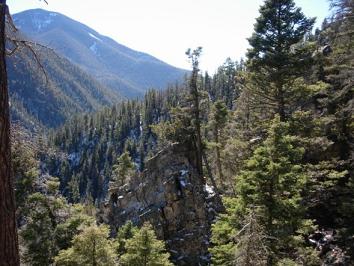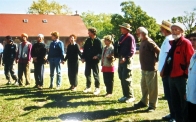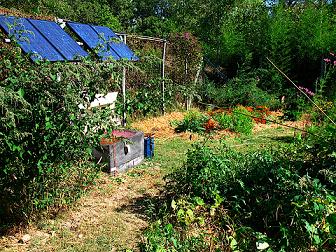The Fundamental Role of the Bioregional Movement
Visit “Welcome Home” for our most enduring words of purpose.
What is a Bioregion?
A life region. A geographical area described in terms of its unique combination of flora, fauna, geology, climate and water features—the whole of which distinguishes it from other bioregions. Thus, natural forms and living communities, including human, become the descriptive features of each bioregion—instead of the politically drawn lines used to define county, state and nation. Watersheds, being an important physical feature of bioregions, are often used to define their boundaries.
 Bioregions are geographic areas having common characteristics of soil, watershed, climate, native plants and animals that exist within the whole planetary biosphere as unique and contributive parts.
Bioregions are geographic areas having common characteristics of soil, watershed, climate, native plants and animals that exist within the whole planetary biosphere as unique and contributive parts.
A bioregion refers both to geographical terrain and a terrain of consciousness – to a place and the ideas that have developed about how to live in that place.
A bioregion can be determined initially by use of climatology, physiography, animal and plant geography, natural history and other descriptive resonance among living things and the factors that influence them which occurs specifically within each separate part of the planet.
Discovering and describing that resonance is a way to describe a bioregion.
Peter Berg & Raymond Dasmann, Reinhabiting a Separate Country, Planet Drum Foundation, 1978
What is Bioregionalism?
Only around 30 years old, Bioregionalism – and the Bioregional movement – represent a comprehensive way of defining and understanding the places where we live, and of living there sustainably and respectfully through ecological design. The bioregional movement has helped spawn and support other movements and trends, such as the Green Party, Permaculture, Ecovillages, Ecological Restoration, Eco-Poetics and much more. At the same time, bioregionalism’s essence has been reality and common sense for native people living close to the land for thousands of years; even beyond human experience, bioregionalism is rooted in the ecological principles of all life. Bioregionalists are lifelong students of how to live in balance with our eco-communities. We recognize that we are part of the web of the life, and that all justice, freedom and peace must be grounded in this recognition.
Bioregionalism re-connects us into the living biosphere through the Places where we live. Bioregionalism acknowledges that we not only live in cities, towns, villages and countrysides; we also live in watersheds, ecosystems, and ecoregions. The awareness of those connections to the planet is vital to our own health and the health of the planet. By discovering our connections to the planet, we find a context for our lives to grow in. This context allows us to find ways to live sustainably in our settlements while at the same time provides us ways to nurture and restore the more-than-human community that surrounds us and which we are dependent on in so many ways. (For more information see Mapping and Water)
 The following statement was adopted by the Continental Bioregional Congress (then called the North American Bioregional Congress) at its first gathering in 1984, and it has been affirmed by many organizations and congresses since that time:
The following statement was adopted by the Continental Bioregional Congress (then called the North American Bioregional Congress) at its first gathering in 1984, and it has been affirmed by many organizations and congresses since that time:
What is a Bioregional Congress?
 For nearly 30 years bioregionalists have been gathering in congresses to envision and develop a realistic, restorative way of life in the bioregions of the Americas. We set our own agendas, operate by consensus and build a common commitment.
For nearly 30 years bioregionalists have been gathering in congresses to envision and develop a realistic, restorative way of life in the bioregions of the Americas. We set our own agendas, operate by consensus and build a common commitment.
Continental Congresses have taken place in the tallgrass prairie of Missouri, the Great Lakes Bioregional (Michigan), Cascadia (Bristish Columbia), the Gulf of Maine, Edwards Plateau (Texas), the Ohio River Valley (Kentucky), Anhuac, Mexico, the Flint Hills of Kansas, and at Earthaven Ecovillage (N.C.). In a sense, there has been just one congress, going in and out of session on an average of every 2-4 years, maintaining its continuity between gatherings through bioregional offices and coordinating councils.
In 2009, we will celebrate the 10th Continential Bioregional Congress at The Farm in Tennessee October 3-11, 2009. Click here for more information.
The Fundamental Role of the Bioregional Movement: The Bioregional Movement acts as a catalyst fo r social and political change in government toward decentralization of power to smaller units of population and land for the purpose of: keeping wealth at home in local communities, preserving and enriching the natural systems of water, air and land, and practicing ways of living that foster sustainable energy use in human endeavors. Change includes redefining the laws governing corporations to ensure they serve societal and planetary interests for health and sustainability. The Bioregional Movement should pioneer new modes of relatedness to the mystery and wonder of the natural world.
r social and political change in government toward decentralization of power to smaller units of population and land for the purpose of: keeping wealth at home in local communities, preserving and enriching the natural systems of water, air and land, and practicing ways of living that foster sustainable energy use in human endeavors. Change includes redefining the laws governing corporations to ensure they serve societal and planetary interests for health and sustainability. The Bioregional Movement should pioneer new modes of relatedness to the mystery and wonder of the natural world.
The above was abstracted (and paraphrased) from a view of one bioregionalist, Gene Marshall—full text can be found on the Bioregional Listserve (July 2005)